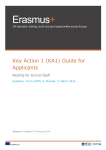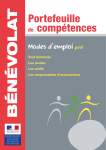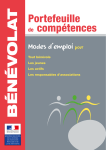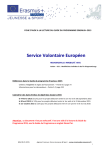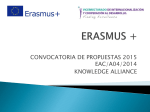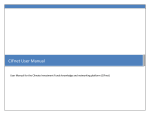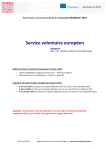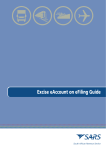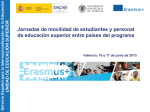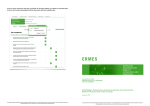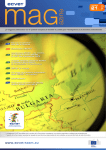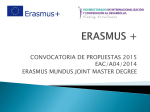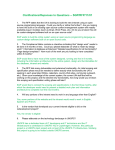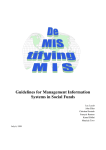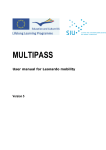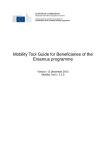Download Erasmus+ Document Template
Transcript
Key Action 1 (KA1) Guide for Applicants Mobility for Young People and Youth Workers Deadline for Round 2: 11am (UK time) on Thursday 30 April 2015 Version 3: 21 April 2015 0 Overview of changes to the guide This document is version 3 of the 2015 Key Action 1 (KA1) Guide for Applicants for Mobility for Young People and Youth Workers. The table below gives an overview of changes made compared to previous versions of the guide: Page number in version 1 of the guide Page 4 Page 27 Page 2-3 New New New Page 14 New New New New Page 23 Page 28 Page 32 Change New page number in version 2 of the guide Version 3 Clarification that Unincorporated Associations and Partnerships are ineligible organisations and cannot be funded under Erasmus+ Further detail on what information to include when applying for Exceptional Costs Version 2 Additional eligibility criteria detailed for Youth Exchanges, EVS and Mobility of Youth Workers. Example of project dates added. Project Total Duration field of eForm explained. Detail of how Project End Date calculates in the eForm. Updated with information about the EVS accreditation process. Information added on what to do if Legal Representative or Contact Person leaves your organisation after your application is submitted. Updated information about Advanced Planning Visits. Note about applications involving Overseas Countries and Territories (OCTs). Added page reference for dissemination information that can be found in the 2015 Erasmus+ Programme Guide. Updated with information on funding costs acting as a contribution to overall project costs. Updated with information regarding specific Exceptional Costs. Updated with information about the alternative submission process. 1 Page 4 Page 27 Page 2-3 Page 11 Page 11 Page 11 Page 12 Page 13-14 Page 19 Page 19 Page 21 Page 22 Page 27 Page 31 Introduction to Key Action 1 Mobility of Individuals Erasmus+ is open to organisations across all sectors of education, training, youth and sport. Any public, private or not-for-profit organisation actively involved in these areas may apply for funding. The overall programme objectives are to: Boost skills and employability Modernise education, training and youth work Focus on young people. Key Action 1: Learning Mobility of Individuals is all about providing opportunities for individuals to improve their skills, enhance their employability and gain cultural awareness. Under Key Action 1 organisations can apply for funding to run mobility projects. These projects enable organisations to offer structured study, work experience, job shadowing, training and teaching opportunities to staff and learners. Key Action 1 for Youth Young people and organisations in the UK that are active in youth work can apply for youth mobility funding under Key Action 1. The draft budget for Key Action 1 for Youth is €9.8 million, of which a maximum of 25% can be allocated to Partner Country activity. Each project can last between 3 and 24 months, and organisations can apply for funding to support any of the following mobility activities within a project: Mobility of Young People – Youth Exchanges Youth Exchanges for people aged 13-30, resident in the countries of the sending and receiving organisations lasting 5 to 21 days, excluding travel time. Group leaders involved in the Youth Exchange must be at least 18 years of age. In the case of informal groups of young people one of the group, who is at least 18 years old must assume the role of representative and take responsibility on behalf of the group. Mobility of Young People – European Voluntary Service (EVS) European Voluntary Service (EVS) for people aged 18-30, resident in the country of their sending organisation, lasting 2 to 12 months. Activities must begin within the first seven days of the month that the activity starts. In case of activities involving at least 10 volunteers who are doing their service together (group service) or involving young people with fewer opportunities, the European Voluntary Service can last from 2 weeks to 2 months (short term EVS). Volunteers can only take part in one European Voluntary Service. The only exception is where an individual has participated in an EVS lasting a maximum duration of 2 months. In this case the individual can be involved in an additional EVS. Mobility of Youth Workers 2 Training and networking for youth workers of any age resident in the country of their sending or receiving organisation. Youth Worker mobility activities can last from 2 days to 2 months, excluding travel time. Note: it is possible to apply for funding for more than one Youth Exchange, European Voluntary Service or Youth Worker mobility in one application. Alternatively you can make separate applications for different mobility types. In either case, your application must demonstrate that the mobilities are supported by a clear and coherent project proposal, common objectives and project plan as the quality assessment will review the project holistically and look for coherence. Who is this guide for? This step-by-step guide is to help UK organisations complete the 2015 Erasmus+ Key Action 1 Learning Mobility of Individuals (Youth) application form. It is for organisations who are considering applying for funding for Youth Exchanges, European Voluntary Service (EVS) or Youth Worker mobility only. If you wish to apply for funding for Key Action 2 or Key Action 3, please see the ‘Apply for funding’ section on the UK website and choose the relevant field. Before you begin Before you begin your application, we recommend completing the following steps: 1. Read more about this type of project. 2. Check that you are an eligible organisation. 3. Read about organisational and financial capacity. 4. Register on the European Commission’s Participant Portal (unless you have done this previously). 5. Ensure you understand the quality criteria against which your application will be assessed. 1. Read more about this type of project We recommend that you read the relevant sections of the UK Erasmus+ website and the European Commission’s Erasmus+ Programme Guide to find out more about Key Action 1 for Youth. For Key Action 1 youth applications the relevant sections are: The Key Action 1 page of the UK website. Pages 29 - 34 and 73 - 85 of the Erasmus+ Programme Guide, which is available to download. For inspiration and case studies, you can search for projects on the Dissemination Platform: http://ec.europa.eu/programmes/erasmus-plus/projects/. 3 2. Check your organisation’s eligibility The following organisation types are eligible to apply for Erasmus+ youth funding: Public body. NGO (CIC, CIO, registered charities, limited company - no share capital). Private limited company (EVS applications as part of Corporate Social Responsibility agenda only). Informal groups of young people aged 13-30 (at least four people, and one member of the group must assume the role of legal representative and be aged 18-30). Please note that, with limited exception, Sole Traders, Unincorporated Associations and Partnerships, are NOT eligible to apply for funding in Erasmus+. We will check your organisation’s status at eligibility stage and if your organisation cannot be verified by the documents that you have uploaded to the participant portal, your application will be ineligible. Organisations must be based and registered in a Programme Country. For more information, please see the specific eligibility criteria for Key Action 1 Youth projects on pages 74 - 77 of the Programme Guide. For the project to be eligible for funding from the Erasmus+ UK National Agency, at least one sending/receiving organisation in each activity must be from the UK. If this is not the case, consider applying to a different National Agency: http://ec.europa.eu/programmes/erasmusplus/tools/national-agencies/index_en.htm. 3. Read about organisational and financial capability 3.1 What is organisational capacity? Applicants need to demonstrate they have adequate capacity to successfully deliver Erasmus+ projects and administer them in accordance with the grant agreement with the National Agency and the programme guide published by the European Commission. The assessment of organisational capacity will consider: the management of the organisation (e.g. details and roles of staff involved in delivery, management of the organisation, including details of any finance and administrative support); its past history, if any, in delivering European Commission funded projects; 4 the number of staff and volunteers who will be involved in managing the project; access to support networks (only for smaller groups); and the results of previous monitoring or audits by the National Agency. Capacity checks of public sector higher education institutions (HEIs), colleges and schools may not be as detailed as for other types of organisation. Note: for HEIs organisational capacity is assessed through the Erasmus Charter for Higher Education. The National Agency will limit the number of live projects an organisation manages at any one time if there is not evidence of sufficient organisational capacity to successfully deliver them. 3.2 What is financial capacity? Erasmus+ grants will not cover all costs – the grant is intended to be a contribution towards the costs of project implementation and mobility activities. Projects must be delivered and reported using only a pre-financing payment or advance. Note: in some cases there might be interim pre-financing payments. A formal financial capacity check does not apply to public bodies and international organisations, or where the grant request is less than €60,000. In all other cases, applicants must demonstrate that they have suitable reserves or income to deliver the project successfully. You must therefore provide a set of accounts, in accordance with relevant UK legislation, not more than 15 months old, on the deadline date of the round to which you are applying. The accounts must show a balance sheet with sufficient free reserves (e.g. cash at bank and debtors) which will exceed the amount of co-financing required and any additional shortfall, given the amount advanced as pre-financing and the total cost of the project. Erasmus+ grants must be used to deliver projects and must not therefore be expected to fund the running of an organisation. Erasmus+ grants must represent no more than 50% of an organisation’s annual income. 3.3 What if my organisation is new or has no accounts? The National Agency may consider applicants who are recently established and have not prepared financial accounts, but priority may be given to established organisations who can demonstrate financial capacity. 3.4 What kind of bank account does my organisation need to receive Erasmus+ funding? All Grants are paid in Euros. It is strongly recommended that you use a Euro bank account to avoid exchange rate losses. Some UK bank accounts can accept Euro payments directly, while others require payments to be routed via another bank or bank account. It is important that the name of your bank account matches the name of your organisation or, in the case of Informal Groups of 5 Young People, the name of the group so that we can make payments to you. If this is not possible please contact the British Council to discuss your options. 4. Register on the European Commission’s Participant Portal Registration is compulsory and you will not be able to submit your completed application form if you have not registered your organisation. If you registered in 2014 there is no need to re-register. Please note that both the applicant organisation and partner organisations, if in a consortium, must have registered on the European Commission’s Participant Portal before completing an Erasmus+ application form. The Participant Portal can be accessed at: http://ec.europa.eu/education/participants/portal/desktop/en/home.html The Participant Portal is accessible via an individual’s ECAS account. A video guide on how to register on ECAS together with a Participant Portal User Manual is on the UK website. Organisations will need to upload evidence of their legal status and a completed financial identification form. Once registered, organisations will receive a nine digit Participant Identification Code (PIC). When a PIC is entered into an application form, the institution’s details will be entered automatically. Please see the Erasmus+ Programme Guide, Part C Information for Applicants, page 232, which contains detailed guidance on how to complete these steps. 5. Ensure you understand the quality criteria against which your application will be assessed In order for you to write a high quality Key Action 1 application, it is essential that you understand how your application will be assessed. The assessment of applications is carried out in two stages: A formal eligibility check undertaken by the NA staff (against the eligibility criteria published in the Programme Guide). A qualitative assessment undertaken by external experts selected for their experience and knowledge of the youth sector. The budget for this Key Action is finite. Funding decisions are made based on the quality score. Experts will assess each section of the application form against the following criteria: Relevance of the project (maximum 30 points) The relevance of the proposal to: o the objectives of the Action (see section "What are the 6 aims of a mobility project") o Quality of the project design and implementation (maximum 40 points) Impact and dissemination (maximum 30 points) the needs and objectives of the participating organisations and of the individual participants The extent to which the proposal is suitable of: o producing high-quality learning outcomes for participants o reinforcing the capacities and international scope of the participating organisations The extent to which the project involves young people with fewer opportunities The clarity, completeness and quality of all the phases of the project proposal (preparation, implementation of mobility activities and follow-up) The consistency between project objectives and activities proposed The quality of the practical arrangements, management and support modalities The quality of the preparation provided to participants The quality of the non-formal participative methods proposed and active involvement of young people at all levels of the project The quality of arrangements for the recognition and validation of participants' learning outcomes, as well as the consistent use of European transparency and recognition tools The appropriateness of measures for selecting and/or involving participants in the mobility activities The quality of cooperation and communication between the participating organisations, as well as with other relevant stakeholders The quality of measures for monitoring and evaluating the outcomes of the project The potential impact of the project: 7 o on participants and participating organisations during and after the project lifetime o outside the organisations and individuals directly participating in the project, at local, regional, national and/or European levels The appropriateness and quality of measures aimed at disseminating the outcomes of the project within and outside the participating organisations You will need to ensure that each section of the application form is completed in full and that the activities conform to the Erasmus+ guidelines and the eligibility criteria (target group, placement duration, partners and financial provisions). You must make sure that each answer refers to the question asked, avoid duplicating information and ensure consistency and clarity. Remember to proof read your application. Note: any application scoring less than half the available points in any one of the 3 quality criteria will not be considered suitable for funding. For example, if an application scored 30 for relevance, 40 for quality, and 12 for impact, it would not be successful, even though 82 is a good score overall. You must therefore make sure that your application is balanced and you give attention to all aspects of the project. Any relevant text you enter will be considered in the quality assessment. Please try however to be concise and give the most relevant detail in the most relevant section of the form. Where to find more help and advice For further information, please refer to the ‘Apply for youth funding’ section on our website. You can find examples of youth work methods and resources for projects based on themes such as inclusion, diversity and participation, on the SALTO website: www.salto-youth.net. The European Youth Portal gives information on opportunities for young people: http://europa.eu/youth/en. EPALE (Electronic Platform for Adult Learning in Europe) is an online network for teachers, trainers and volunteers. The Erasmus+ team at the British Council is here to help you with queries regarding your application. You can contact us by phone on 0161 957 7755 or by email at [email protected]. Step-by-step guide to completing your application Introduction to the eForm 8 It is compulsory to complete the electronic application form (eForm) when applying for Key Action 1 Youth funding. The eForm is available to download https://erasmusplus.org.uk/apply-for-youthmobility-funding#howtoapply. Please ensure you download the correct application form. The eForm is a PDF file which needs to be opened and edited using Adobe Reader. It is recommended that applicants use the latest version of Adobe Reader which is free to download from www.get.adobe.com/reader. The eForm will work with some earlier versions of Adobe Reader and we recommend version 10 or above as a minimum. When you click on the link to download the eForm from the Erasmus+ website, the form will open as a one page PDF displaying the following message in red text: The form has been opened inside a web browser window. Please download the form to your PC in order to be able to properly save the form after filling it in. In order to save the form on your computer or network, click on the ‘Save a copy’ button in the left-hand corner of the PDF. This will save the eForm locally on your computer. You will now be able to click on the form in your local files and open it up to edit. In order to avoid any older versions of Adobe Reader opening the file by default, it is best to open up the Adobe Reader software first then go to File>Open and open the eForm. As long as you have saved the eForm locally, you do not have to be connected to the internet to enter information into the form. The downloaded eForm can be saved and closed at any moment without losing the encoded data. Please note: you will need to be connected to the internet to complete certain functions such as checking your PIC code and validating the form using the ‘validate’ button at the bottom of each page. We recommend that you validate each page of the eForm as you complete it as some functions, such as the automatic calculations in the budget section, will not work unless the pages are validated. You must fill in the required fields on the form, using the mouse or tab keys to navigate. Please note that fields appearing in grey where you are unable to enter data are “Pre-filled or Calculated Fields”. You will not be able to modify these, and they will display either default values, calculation results or data already inputted in other fields or tables within the application form. If there are tables and fields in the form where multiple entries are possible or blocks/sections that can be repeated, you can add or delete rows or sections by clicking on the ‘Add’ and ‘Delete Last’ or the ‘+’ or ‘-’ buttons. Please note the ‘CEDEX’ field is only applicable to French organisations and can be left blank where applicable. Clicking the ‘validate’ button at the end of each page will ensure you can identify any missing fields as you go along. It is important to remember that you will need to save your application as you go along in order to ensure that the information you have entered is retained in the form. This way, you can return to complete it as many times as necessary. Please allow sufficient time to complete the eForm, as functions such as copy and paste do not always work within the form. A. General Information 9 This section consists of an overview of the application form. B. Context This section consists of a data table containing information specific to the application being made. Data fields including Programme, Key Action, Action, Action Type, Call, Round and Deadline for Submission have already been pre-filled. Applicants must check that the pre-filled fields: Key Action, Action and Action Type correspond to the funding being applied for. Applications for Key Action 1 - Learning Mobility of Individuals for Youth Mobility must ensure that the following details are consistent. Key Action: Learning Mobility of Individuals Action: Mobility of Learners and Staff Action Type: Youth Mobility In this section applicants are only required to complete the field in relation to the languages used to fill in the form. All applications submitted to the UK National Agency must be completed in English. Applicants must therefore select English from the drop down box for this field. B.1. Project Identification The only pre-filled information will include organisation name and the form hash code. All other sections must be completed by applicants. Project title: Please choose a name for your project that is different from your organisation’s name. Project Acronym: Please enter any acronym or alternative name for your project title here. Project Start Date: Select a date from the calendar. This must be the earliest date from which you will need to spend the grant and before your activity. Despite showing the earliest start date, we encourage applicants to allow enough time before starting activities As best practise, you should allow at least a month after the earliest start date so that in case the funding is not received by the earliest start date, you have sufficient time to plan accordingly. The table below shows the earliest possible start date for activity depending on which funding Round you apply for. Application deadline Earliest start date for activity 11am UK time for all deadlines 10 Latest start date for activity 4 February 2015 1 May 2015 30 September 2015 30 April 2015 1 August 2015 31 December 2015 1 October 2015 1 January 2016 31 May 2016 Please be mindful that you should plan in enough time before your activities start to be able to purchase economical travel tickets Project Total Duration: A youth mobility project can last between 3 and 24 months. Please select the duration of your project from the dropdown box. The overall project duration will need to encompass all project related activities from promotion and recruitment through to evaluation and dissemination. It is important therefore to consider a realistic project duration to be able to carry out all project activities to a high standard. Project End Date: The project end date will pre-populate based on the project start date and the project total duration that you have entered. For example, for the application deadline of 30 April 2015, a 24 month project starting on 1 October 2015 would run until 1 October 2017. Applicant Organisation Full Legal Name (Latin characters): This field will populate based on your PIC (see section C.1). B.2. National Agency of the Applicant Organisation Identification: Select UK01 from the drop down box. C. Participating Organisation(s) C.1. Applicant Organisation This section asks applicants to provide information relating to the applicant organisation. In advance of completing this section of the form applicants must register their organisation on the European Commission’s Participant Portal to obtain a PIC number. Please refer to page 5 of this guide for further information. Applicants must enter their organisation’s PIC number into the application form and click ‘Check PIC’. Once entered, the form will automatically populate the applicant organisation’s information. The information entered into this section of the form will be based on the information provided during the PIC registration process. If there are any changes to the information originally provided participants should log back onto the Participant Portal and update the information accordingly. 11 C.1.1 Profile This section of the form will also be pre-filled using the information submitted on to the European Commission’s Participant Portal. Please check that this information is accurate and if not, update in the Participant Portal. Is your organisation: a public body at regional/national level; an association of regions; a European Grouping of Territorial Cooperation; or a profit-making body active in Corporate Social Responsibility? – Please select ‘yes’ or ‘no’ from the dropdown box. If you experience problems with this stage and the fields are not populating correctly, we recommend that you check your organisation’s registration in the Participant Portal. If the field ‘Type of Organisation’ found in this section of the eForm has not been completed in the Participant Portal then the applicant organisation details will not populate the form and this will cause an error to occur. This field is not compulsory during the Participant Portal registration process but is essential for the completion of the eForm. C.1.2 Accreditation If you are applying for European Voluntary Service (EVS), you must have been accredited before the deadline. The lead organisation and all partners involved in the project must have accreditation for the duration of the project. EVS activities will be rejected if organisations involved are not accredited at the time of submission. You must allow a minimum of six weeks for the application process before the deadline that you are looking to apply for. Accreditation is for organisations that want to send or receive volunteers, or to act as coordinators of a project. An organisation can seek accreditation as a Sending, Receiving and/or Coordinating Organisation on the same official form. The form can be found on the Erasmus+ website at https://erasmusplus.org.uk/european-voluntary-service-accreditation-for-youth-organisations. Before submitting an accreditation application, a PIC number (Participant Identification Code) is needed. The contact person provided in the form is responsible for keeping information up-to-date, posting volunteering opportunities on the European Youth Portal and informing the Agency/SALTO if there are periods during which the organisation does not intend to be involved in any projects. Please note informal groups of young people are not eligible for EVS accreditation. The Volunteering Platform hosted on the European Youth Portal is a tool to find partners in the framework of EVS. Relevant information and a description about accredited organisations is provided on the website. 12 C.1.3. Background and Experience The information in this section will inform the assessment of your organisation’s capacity to manage the project and proposed grant successfully. Please briefly present your organisation: Please include the aims of your organisation, its history, its location and how the activities proposed in this application fits into other programmes or activities you deliver. You must also include details of the young people your organisation typically works with in terms of geographic location and any additional needs they might have. For example, you may wish to enter the proportion of young people with disabilities, from families in receipt of benefits or those with English as a second language, if you feel that this information is pertinent. What are the activities and experience of your organisation in the areas relevant for this application? Please detail how your organisation’s previous experience of delivering projects or activities or other work has built the skills and knowledge needed for the activities you propose in this application. Please detail if this is a project format that you have delivered before. Please give information on the key staff/persons involved in this application and on the competences and previous experience that they will bring to the project. Please give details of the number of administrative and delivery staff involved in this project (detailing paid staff and volunteers) and their competences or relevant experience or qualifications. Have you applied for/received a grant from any European Union programme in the 12 months preceding this application? Please select from the drop down menu. If you select ‘yes’ here, complete the table with the relevant information. To add more activities, click on the + button. To delete activities, click on the - button. If you have been involved in previous projects but do not know the exact details please contact your National Agency. C.1.4. Legal Representative Enter the details of the person who is authorised to enter into a legally-binding commitment on behalf of your employer. This may be your Finance Manager or another member of the Senior Management Team. If your application is approved this person will also be the signatory for the Grant Agreement and the person who takes on the terms and conditions attached to the grant on behalf of the organisation. Please complete every field in this section. If the appropriate contact address for the legal representative is different from the main contact address for the applicant organisation, you will need to tick the box to indicate that and complete the address details. 13 Please note: it is important that the legal representative details are consistent throughout the application form and in the Declaration of Honour. If there is inconsistency your application will be ineligible. Please Note: If after the submission of your application you find that your legal representative leaves your organisation; is no longer able to fulfil the duty; or their contact details change, you must inform us as soon as possible. It is important that we have the most up-to-date information about your project and organisation. C.1.5. Contact Person We will use these details as the first point of contact for the application and, should it be successful, the grant. Please complete every field in this section. If the address of the contact person is different from the organisation address, you must ensure there is a check in the box next to ‘if the address is different from the one of the organisation, please tick this box’ and then provide additional address details. Please Note: It is vital that the details you supply are correct and up-to-date. Due to data protection laws and procedure we are only able to provide project specific information to the official contact person and legal representative of the project using the details provided to us. If after the submission of your application you find that the contact person / their contact details change you must inform us as soon as possible. C.2 Partner Organisation All Youth Exchanges, European Voluntary Service and Youth worker Mobility projects must include a minimum of one partner (bilateral) or more (tri or multilateral) from Programme Countries to be considered eligible. Please click the button to add information about the partner organisation(s). If you do not add a partner organisation at this stage, you will not be able to amend this at a later date. Any partner organisations will also need to have a registered PIC. Please repeat the same steps as for Applicant Organisation when adding information about partner organisations. You can add more than one partner, and any organisation or group which you intend to partner with must be added here. You must annex a signed partner mandate for each partner to the application form at submission stage. The EC’s partner mandate template, which is mandatory for youth applicants to complete at application stage, is available from https://www.erasmusplus.org.uk/apply-for-youthmobility-funding. 14 D. Description of the Project Why do you want to carry out this project? What are its objectives? How does it link to the objectives of the Erasmus+ programme and this specific key action? What are the issues and needs you are seeking to address through this project? All projects should propose to address a need for their young people, community or organisation. Please outline how this need and the objectives were established, i.e. through research, planning meetings. Where possible, Youth Exchanges and EVS projects should demonstrate how young people are actively involved in shaping the project proposed. The objectives of the project must clearly seek to address the needs you establish and be relevant to the individual participants and organisation. Please outline how this project links to the objectives of the Erasmus+ programme and this specific key action. How did you choose your project partners? What experience and competences will they bring to the project? Please also describe how the project meets the needs and objectives of your partners. Strong partnership is crucial to the successful delivery of an international project. Please detail how the partnership was formed and their contribution in terms of the skills and experience they have that is relevant to this project. Please outline how this project links to the needs and objectives of your partners too as it is a joint application. What are the most relevant topics addressed by your project? Select from the dropdown menu. You may choose up to three. Do not worry if this doesn’t cover everything. Add more by clicking on the + button and remove them by clicking on the - button. If your project is to address more than three topics, please choose the most relevant. E. Participants’ Profile Please describe, for each planned activity, the background and needs of the participants involved and how these participants have been or will be selected: Please detail the process for selecting participants from all partner groups that has taken place or will take place and how this selects the most suitable participants whilst ensuring a fair process. Please note that it is expected that participants normally would attend no more than two Youth Exchanges and not more than one long-term EVS (over two months), to ensure opportunities are made available to as wide a group of people as possible and to make best use of European funds. Participants must be resident in the country of their sending/receiving organisation. Please provide, for each planned activity, general information on the age of participants and describe how you will ensure a gender balance in the main activities carried out in your project. Please describe the participants’ actual or likely age ranges, gender, ethnicity or other pertinent information, detailing how in particular you will ensure a gender balance. 15 E.1. Participants with Fewer Opportunities Please see the Erasmus+ Programme Guide page 13 for more information on participants with fewer opportunities, Does your project involve participants facing situations that make their participation in the activities more difficult? Please select ‘yes’ or ‘no’ from the drop down menu. How many participants (out of the total number) would fall into this category? Please give the actual or likely number. Which types of situations are these participants facing? Please enter the actual or likely profile of the participants this project will involve. For more detail on each of the categories, please review page 13 of the Erasmus+ Programme Guide, see Equity and Inclusion. E.2. Learning Outcomes Which competences (i.e. knowledge, skills and attitudes/behaviours) are to be acquired/improved by participants in your project? Please identify the competences that specific activities and methods will develop. There should be a clear link between the aims of your project, the activity and the learning outcomes. They should also be relevant to your participants and address the need you identified for this project. The Erasmus+ programme promotes the use of instruments/certificates like Europass, ECVET and Youthpass to validate the competences acquired by the participants during their experiences abroad. Will your project make use of such European instruments/certificates? If so, which ones? Please select from the drop down menu. Are you planning to use any national instruments/certificates? If so, which ones? Please list here any additional tools or accreditation you will use to support learning and reflection as well as recognition of learning outcomes, for example ASDAN or other UK accreditation. How will you use the European/national instruments(s)/certificates(s) selected? Please detail how the instruments/certificate will be used. Remember to include the methods that support reflection and documentation of the learning outcomes in the daily timetable of each activity. F. Preparation F.1. Practical Arrangements How will the practical and logistical matters of the project be addressed (e.g. travel, accommodation, insurance, safety and protection of participants, visa, social security, mentoring and support, preparatory meetings with partners etc.)? Please detail how and when 16 you plan to deliver these practical aspects and which partner or individuals will take responsibility for them. See pages 265-270 in the Erasmus+ Programme Guide for more details. Outline the risks you identify in this project, in relation to tasks, participants and location, as well as your plans for mitigating these risks to ensure the safety of all involved. This must include agreement on emergency procedures and a code of behaviour for participants. Note your plans for obtaining suitable insurance and managing any additional visa requirements and legal aspects to evidence how you will manage these. We expect that you plan to comply with UK legislation and consider relevant national legislation in the country of each partner. In the UK, this includes in particular the UK Data Protection Act 1998, legislation/statutory guidance relevant at any time to the safeguarding and protection of children and vulnerable adults (including without limitation, the UN Convention on the Rights of the Child and the Children Act 1989, Safeguarding Vulnerable Groups Act 2006). Please follow the FCO travel advice for the countries to which you will send participants. Support to participants, e.g. mentoring of EVS volunteers, must be detailed here, in line with the EVS Charter standards – see pages 265-270 of the Programme Guide. Mentors are expected to provide regular meetings for volunteers to review learning and offer personal support and are responsible for assisting their integration into the local community. F.2. Project Management How will you address quality and management issues (e.g. setting up arrangements with partners, learning arrangements with participants, etc.)? Please describe the process you have established for agreeing roles and responsibilities with partners in order to ensure quality learning outcomes, as well as good administration and delivery of the project. Please then describe the process for establishing suitable methods and agreeing and monitoring learning outcomes for participants. Ensure that you detail how you intend to facilitate their active involvement and reflection to ensure the relevance and quality of these outcomes. F.3. Preparation of Participants What kind of preparation will be offered to participants (e.g. task-related, intercultural, linguistic, risk-prevention etc.)? Who will provide such preparatory activities? Please outline the training plan for participants or organisers/group leaders, as deemed necessary for the success of the project. This plan should detail what training will be provided, when and by whom. It should pay attention to not only task based training to ensure participants’ safety and ability to engage with activities but provide adequate support for the intercultural and linguistic learning expected. G. Main Activities 17 Please explain the context and objectives of the activities you are planning and in which way they meet the objectives of the project. Outline, for all activities, the context and objectives and detail how they meet the objectives of the project, as given in your Project Description in section D. What are the basic elements of the main activities you plan to organise? For each activity, remember to describe at the very least all of the following: type of activity, venue(s), planned dates, working methods used, countries involved and the role of each project partner in the activity: For all activities, you must provide a timetable, which must be uploaded as an annex to the eForm. The European Commission has published a Youth Activity Timetable Template for KA1 applications. The template can be downloaded from https://www.erasmusplus.org.uk/apply-foryouth-mobility-funding. For each Youth Exchange activity, the timetable annexed will detail the programme for each day. For each European Voluntary Service, the timetable annexed must provide a sample of one week’s activity plan. For Youth Worker Mobility, the timetable annexed must provide a sample of either a week’s activity or programme overview if planning an activity of several weeks. In addition to your timetable, you must note how you have decided on this programme, explaining how you have ensured that your methods and activity are relevant to your objectives and are relevant to the learning outcomes and impact you anticipate. All activities will need to demonstrate compliance with the principles and provisions described in the Programme Guide, Annex I ‘Mobility project for young people and youth workers’, pages 265 270. This includes the use of a variety of informal and non-formal methods to generate learning. Formal methods should be strictly limited. All activities should include space for participants to reflect on their learning (ideally using Youthpass) and should encourage active participation, creativity and initiative. European Voluntary Service (EVS) activities will need to demonstrate that tasks are able to be shaped by the young people to reflect their interests and abilities. Routine, manual and repetitive administrative tasks must be kept to a minimum. Tasks must not place high level of responsibility or risk on volunteers or perform tasks that match the profile of an employee, since this should clearly be a learning service that offers community interest or benefit. Youth Exchange activities should clarify the theme that will be the focus of the Exchange and how this reflects the needs and interests of participants. If applicable, how do you intend to cooperate and communicate with your project partners and other relevant stakeholders? Please outline the methods by which you will ensure regular communication with your partners or other project stakeholders. Describe how you plan to work together. Good partnership is crucial, so you must present a clear set of roles and responsibilities for all involved in the activity delivery, project management and administration. Please outline any scheduled meetings or other methods by which you will maintain contact before, during and after activity. If applicable, please explain the need for accompanying persons. Accompanying persons may be included where necessary to enable a participant with special needs to attend. Please explain why the accompanying person is required. 18 G.1. Activities’ Details An activity is defined as either: a Youth Exchange: minimum 16 participants and maximum 60 participants excluding group leaders. Minimum 4 participants per group excluding group leaders. Each national group must have at least one group leader; European Voluntary Service [EVS]: maximum 30 volunteers for the whole project; Mobility of Youth Workers: This activity supports the professional development of youth workers, through the implementation of activities such as transnational/international seminars, training courses, contact-making events, study visits, etc. or job shadowing/observation periods abroad in an organisation active in the youth field. Up to 50 participants including trainers and facilitators. Advanced Planning Visits For youth exchange and EVS activities, you can also apply to carry out an Advance Planning Visit (APV). The APV is used to plan the practicalities of running and implementing activities to ensure the project activities are successfully carried out. For EVS applications, the APV can only be used where the application involves young people with fewer opportunities. Please note APV travel is included in the Activities section G.1. APV accommodation can be applied for under Exceptional Costs. If the project foresees an APV, then the following eligibility criteria must be respected: duration of the APV: maximum 2 days (travel days excluded); number of participants: 1 participant per group. The number of participants can be raised to 2 under the condition that at least 1 of the participants is a young person taking part in the activity. Every activity you plan to do must be listed in this section. We cannot fund activities if they are not listed in the application form. Some changes may be requested and approved by us at a later date, but if an activity is added we will not be able to increase funding to cover it. Please note if your application will involve organisations based in Overseas Countries and Territories (OCTs), you may be unable to select them in the Activities Section. This is currently a technical issue with the form and may result in your form not being validated. Please contact us at [email protected] immediately to discuss this and we will provide guidance on how to proceed. For each activity, complete the fields in the grid as follows. Activity No. populates automatically. Activity Type: Select from drop down menu. See above for descriptions. 19 Flow No: Flow is the term used to describe a separate instance of travel within one activity. For example, if your organisation were to organise a training event for youth workers, the event is one activity, and each national group, travelling from a different country, would be a separate flow. The figures entered here are used to calculate the Budget in Section I. Additional flows can be added, or erroneous ones removed, using the + or – symbols. Note: if you are carrying out an advance planning visit (APV) this must be entered here as an additional activity. Note: in EVS applications, APVs may only be undertaken in projects involving young people with fewer opportunities. Country of origin: Please select from the drop down menu. Country of Destination: This field (along with the country of origin) is used to calculate the rate per person per day for the proposed flow (known as ‘Individual support’). Please refer to the table on page 23 for a breakdown by country of the daily rate. It will populate automatically, using those rates. Venue (City): insert the destination city. Distance Band: Use the distance calculator supported by the European Commission to calculate the one-way distance. Start Date: enter the start date of the activity (excluding travel days). End Date: enter the end date of the activity (excluding travel days). Total Duration Excluding Travel (days): this field is automatically calculated. The rate is calculated per participant per day. Note the following minimum and maximum durations: Youth Exchange: from 5-21 days, excluding travel time. European Voluntary Service: 2-12 months, 2 weeks-2 months for group service (at least 10 volunteers who are doing their service together) or EVS involving young people with fewer opportunities (short term EVS). Mobility of Youth Workers: 2 days to 2 months (excluding travel time). Travel Days: enter the number of travel days. No. Participants: please enter total participants in this flow (this includes all young people and group leaders. Note: in Youth Exchange group leaders must be at least 18 years of age). This is multiplied by the daily rate to give the travel budget. No. Participants with Special Needs: please enter the total number of participants who will require additional support to aid their participation in the activity. Participants with Fewer Opportunities: please enter the total number of participants who have fewer opportunities. Accompanying Persons: Please enter the total number of group leaders and any specialist staff needed to support the participation of the young people with Special Needs. 20 You may find that these activities will change as your project evolves. Whilst this is not a problem, please note that the National Agency cannot revise grant awards upwards e.g. if each mobility were to last twice as long as planned, the grant could not be amended to accommodate that. G.1.1 Summary of Activities and Participants This section automatically populates with a summary of the information added above. H. Follow-up H.1. Impact What is the expected impact on the participants, participating organisation(s) and target groups? List the expected outcomes for participants resulting from their planned learning and active involvement and participation in the project, such as knowledge, skills and changes in attitude or behaviour. In addition, you may plan that these outcomes may have a further impact on their employment status, ability to access further education, wellbeing or lifestyle. Please note the most relevant and realistic outcomes. For participating organisation(s), please detail how this activity might generate organisational learning or specific skills for their staff. Describe the influence this project may have on their future work. What is the desired impact of the project at the local, regional, national, European and/or international levels? Consider if this project will develop the participating organisations’ or participants’ understanding of an issue, youth work or train them in any new methodology that they can implement in their local community for example. Will this raise the profile of an issue or an organisation locally, nationally or internationally? Highlight here any activity you plan to involve the wider community in your project, so that they benefit too. Community involvement and benefit is an expectation of EVS projects in particular and can bring added value to all projects. H.2. Dissemination of Project Results Which activities will you carry out in order to share the results of your project outside your organisation and partners? What will be the target groups of your dissemination activities? You must detail your plan to share the outcomes of your project. At the end of your project, you are expected to share the lessons learnt, tools or methods developed, so that others can benefit from this. It must be clear how you will raise awareness, share concepts or solutions, as well as influence policy or practice through these dissemination activities. There is an Erasmus+ dissemination platform: http://ec.europa.eu/programmes/erasmus-plus/projects/. Dissemination activity may be in the form of local meetings, workshops or discussions with members of a wider community and you may use hand-outs, reports, evaluations or video to assist this. You might plan to get press coverage or invite local councillors or decision makers to dissemination events. The Erasmus+ marketing team is always keen to hear about interesting case studies. 21 Please refer to the Programme Guide (pages 297-303) for further information about dissemination. H.3. Evaluation Which activities will you carry out in order to assess whether and to what extent your project has reached its objectives and results? You are expected to include a final evaluation of the project, in which you will be able to assess whether (or to what extent) the project has been a success. This evaluation should highlight the learning outcomes of all involved. We encourage evaluation before and during the activity, as well as the final evaluation. This helps with establishing baselines (and therefore seeing what has improved), as well as fine-tuning the project as it goes. I. Budget An EU grant is an incentive to carry out a project which would not be feasible without the EU financial support, and is based on the principle of co-financing. Co-financing implies that the EU grant may not finance the entire costs of the project; the project must be funded by sources of cofinancing other than the EU grant. The Erasmus+ grant is regarded as a contribution to your project costs and may not cover the total cost of your project. When applying for a Key Action 1 project for youth mobility you are eligible to receive funding for the following cost headings on a per participant basis: Travel (based on unit cost). Organisational Support (based on unit cost). Special Needs Support (based on real cost). Exceptional costs (based on real cost). Individual Support (EVS only- based on unit cost). Linguistic support (EVS only – based on unit cost). Applicants must calculate a project’s provisional budget at the application stage according to the rates outlined on the following pages. Please note: if you miscalculate your budget and request less than you are entitled to, you will only receive up to the amount requested. You must ensure that the budget provided is consistent with the activity described in your application form. Please note that the UK National Agency cannot award any funding over the amount requested, so please ensure that you check your budget thoroughly before submitting the eForm. When completing the budget section of the eForm it is important to note that automatic calculations will only take place when you press the ‘Validate’ button on the relevant page of the eForm. You will need to be connected to the internet for the page to update, and you will 22 need to press the Validate button on each of the budget pages as you progress through the eForm. The European Commission’s technical guidelines contain more detailed technical advice and guidance on completing the budget section of the eForm. The technical guidelines can be downloaded from the UK website (under Key Documents) at www.erasmusplus.org.uk/key-action1/mobility-for-young-people-and-youth-workers. I.1. Travel Travel is based on the distance per participant from the UK point of origin to the host. Travel is calculated on a unit cost basis and will be payable according to the travel distance. Travel distances must be calculated using the distance calculator supported by the European Commission at http://ec.europa.eu/programmes/erasmus-plus/tools/distance_en.htm. Please note that the ‘travel distance’ measures the distance for a one-way journey but the travel costs have been calculated for a return journey. The distance bands are as follows: Travel distance between: Contribution towards return travel costs, per participant (including accompanying persons) 0 - 9 km €0 10 – 99 km € 20 100 - 499 km € 80 500 - 1999 km € 170 2000 - 2999 km € 270 3000 - 3999 km € 400 4000 - 7999 km € 620 8000 km + € 830 Travel rates for EVS and Youth Worker Mobility Travel distance between: Contribution towards return travel costs, per participant (including accompanying persons) 0 - 99 km €0 Travel rates for Youth Exchanges 23 100 - 499 km € 180 500 - 1999 km € 275 2000 - 2999 km € 360 3000 - 3999 km € 530 4000 - 7999 km € 820 8000 km + € 1100 All fields will be pre-filled for applicants. I.2. Individual Support (EVS only) Individual support is calculated on a unit cost basis, according to the country of destination and the duration of the activity. It is intended as pocket money and not expected to cover food or accommodation costs. EVS 14 to 59 days 2 to 12 months Belgium A5.4 (euro per day) (euro per day) 4 A5.5 (euro per month) (euro per month) 110 Bulgaria Czech Republic Denmark Germany Estonia Ireland Greece Spain France Croatia Italy Cyprus Latvia Lithuania Luxembourg Hungary 3 4 5 4 3 5 4 4 5 4 4 4 3 3 4 4 70 90 145 110 85 125 100 105 115 90 115 110 80 80 110 90 24 Malta Netherlands Austria Poland Portugal Romania Slovenia Slovakia Finland Sweden United Kingdom former Yugoslav Republic of Macedonia Iceland Liechtenstein Norway Turkey Partner Country 4 4 4 3 4 2 3 4 4 4 5 2 110 110 115 85 100 60 85 95 125 115 140 60 5 5 5 3 2 135 120 135 80 55 25 I.3. Organisational Support Organisational support refers to costs directly linked to the organisation, management and implementation of mobility activities (exc. subsistence) and is calculated on a unit cost basis, per participant: Youth Exchanges 14 to 59 days (euroA5.1 per day) 37 (euroA5.2 per day) 20 Bulgaria Czech Republic Denmark Germany Estonia Ireland Greece Spain France Croatia Italy Cyprus Latvia Lithuania Luxembourg Hungary Malta Netherlands Austria Poland Portugal Romania Slovenia Slovakia Finland Sweden United Kingdom former Yugoslav Republic of Macedonia 32 32 40 33 33 39 38 34 37 35 39 32 34 34 36 33 37 39 39 34 37 32 34 35 39 39 40 28 17 17 21 18 18 21 21 18 19 19 21 21 19 18 21 17 20 21 18 18 20 17 20 19 21 21 21 15 500 490 630 520 520 610 610 530 570 570 610 610 550 540 610 510 600 620 540 540 600 500 580 550 630 630 630 440 53 54 72 58 56 74 71 61 66 62 66 58 59 58 66 55 65 69 61 59 65 54 60 60 71 70 76 45 Iceland 39 21 610 71 Belgium European Voluntary Service 26 Mobility of 2 to 12 months youth workers (euro per day) A5.3month) A5.6 (euro per 590 65 Liechtenstein Norway Turkey Partner Country 39 40 32 29 21 21 17 15 610 630 500 440 74 74 54 48 I.4. Special Needs Support Special needs support refers to any costs directly relating to participants with disability and accompanying persons that will incur additional expense in support of their participation (i.e. specialist equipment). Special needs support is calculated on an actual cost basis and will be assessed case-by-case. Please make it clear in the narrative and the budget what items or services are required and the cost breakdown. This must be supported in the narrative text of the application form. I.5 Exceptional Costs Exceptional costs are calculated on an actual cost basis. Please state the detail of your proposed exceptional costs within the narrative section. For the cost of each item please include a detailed breakdown (i.e. 3 visas each at £50). Where the item relates to young people with fewer opportunities, please provide a clear justification that links the exceptional cost item to the participation of the proposed young people. The funding rules state that these costs (based on actuals) are specifically to support the following: For Youth Exchanges only - Costs to support the participation of young people with fewer opportunities (excluding costs for travel and organisational support for participants and accompanying persons). For EVS only - Costs in support of reinforced mentorship and specific preparation in the case of participation of young people with fewer opportunities. For EVS only - costs to support the selection and participation of young people affected by situations such as homelessness, drug/alcohol dependency, mental health issues and/or those with criminal backgrounds. Visa and visa-related costs, residence permits, vaccinations. For Youth Exchanges and EVS activities that involve young people with fewer opportunities only - Costs for accommodation for Advanced Planning Visits (maximum 2 days’ activity and maximum 2 participants if one is a young person). Costs for providing a financial guarantee (75% of eligible costs). J. Project Summary 27 Applicants must provide a well-written, comprehensive summary of their project within the application. Project summaries must be written in plain, clear English and free from jargon. This is of particular importance as it provides a description of the project to the general public and will be used in EC/EA and/or NA documents. The summary will also be included on the Erasmus+ Dissemination Platform. It is important to be concise and clear and mention at least the following elements: Context/background of project. Objectives of the project. Number and profile of participants. Description of activities. Methodology to be used in carrying out the project. A short description of the results and impact envisaged and the potential longer term benefits. J.1. Summary of Participating Organisations This is a pre-populated table based on information taken from earlier sections of the application. J.2. Budget Summary This is a table providing an overview of the activity number, activity type and grant requested for the project. An additional table is then populated below for costs relating to organisational support. J.2.1. Project Total Grant This pre-populated table contains the total combined grant requested for the project. It is imperative that you check this amount is correct against your own calculations and resolve any issues before submitting your application. K. Checklist Before submitting online your application form to the National Agency, please make sure that it fulfils the eligibility criteria listed in the Programme Guide and check that: you have used the official Key-Action 1 application form. all relevant fields in the application form have been completed. 28 you have chosen the correct National Agency of the country in which your organisation is established. the application form has been completed using one of the official languages of the Erasmus+ Programme Countries. you have annexed all the relevant documents: o the Declaration of Honour signed by the legal representative mentioned in the application. o the mandates of each partner to the applicant signed by both parties. o the timetable of each activity. all participating organisations have uploaded the documents to give proof of their legal status in the participants’ portal (for more details, see the section "Selection Criteria" in Part C of the Programme Guide). for grants exceeding 60 000 EUR, you have uploaded the documents to give proof of your financial capacity in the participants’ portal (for more details, see the section "Selection Criteria" in Part C of the Programme Guide). Not applicable in the case of public bodies or international organisations. you are complying with the deadline published in the Programme Guide. you have saved or printed the copy of the completed form for yourself. L. Data Protection Notice Applicants are required to read the data protection notice in advance of signing the Declaration of Honour. M. Declaration of Honour The legal representative of the applicant organisation must print the Declaration of Honour, read it carefully, complete the declaration section by hand and sign it (the National ID and organisation stamp are not required in the UK for youth applicants). The signed Declaration of Honour then needs to be scanned and attached as an annex before application form is submitted online. It is essential to submit the Declaration of Honour. Failure to submit the Declaration of Honour, signed by the legal representative, will result in your application being ineligible. N. Annexes The following documents must be annexed to your eForm: The Declaration of Honour signed by the legal representative mentioned in the application. 29 The mandates of each partner to the applicant signed by both parties. The Youth Activity Timetable Template. Please ensure that all documents specified in the checklist (see section K) are submitted electronically with your application. To attach documents click the ‘add’ button on the right hand side of the box displayed. This will then open up an additional window which will allow applicants to browse files on your computer and upload. Please note that only .pdf, .doc, .docx, .xls, .jpg, .txt, .odt and .ods files can be submitted electronically with an application no other files will be accepted. A file which has been added in error can be removed by clicking the ‘remove’ button which replaced the ‘add’ function on the right hand side of the table. You may find some limits to the total number of documents you can upload. In this instance please scan all similar documents in one attachment to avoid this issue. O. Submission O.1. Data Validation Applicants must ensure they have validated all sections of the application before submitting. O.2. Standard Submission Procedure Applicants should only submit an application form once they are happy with the finalised version. Applicants need to ensure that they are connected to the internet in order to submit their completed application. Applicants should also ensure that all sections of the form are valid and all annexes are attached before submitting the form. To submit the form applicants will need to be connected to the internet. The UK National Agency advises that applicants save the final completed version of the eForm on their desktop in case of any technical issues with submission. Applications must be submitted online by the relevant deadline: Deadline for Round 1: 11am (UK time) on Wednesday 4 February 2015 Deadline for Round 2: 11am (UK time) on Thursday 30 April 2015 Deadline for Round 3: 11am (UK time) on Thursday 1 October 2015 If your application is submitted after the deadline, and the alternative submission procedure outlined below is not completed in time, your application will be deemed ineligible. 30 O.3. Alternative Submission Procedure This is only applicable if applicants are unable to submit their application online due to a technical error. Please see error messages below that are not technical errors. Please note: if your error message says one or more fields has been completed incorrectly, this is not a technical error. 1. Take a screenshot of the submission summary page demonstrating the electronic form could not be submitted online. 2. Email the UK National Agency team managing this Key Action at [email protected] with a copy of your application, any annexes and the screenshot attached within two hours of the application deadline. i.e. by 1pm UK time. In the subject line of the email please type KA1 Youth Round 2 application form – [insert here the name of your organisation]. Please note than the UK National Agency will only accept applications via the Alternative Submission Procedure if, other than emailing the eForm to us within the 2-hour time frame following the deadline, a failed submission attempt in the form of an Error i.e. ‘ERR-’ (but not ERR-01 or ERR-06) is recorded under ‘Status’ in the ‘Submission Summary’ section of the eForm with a timestamp prior to or on the deadline date/time. If any of the following ‘Statuses’ appear in ‘Submission Summary’ your application won’t be accepted under the Alternative Submission Procedure: 1. ‘ERR-01’ as this Error relates to invalid data/missing fields in the eForm. This is not considered to be a technical issue and can be rectified by the applicant by correcting the application form and validating it again. 2. ‘ERR-06’ as this Error means that there are errors with the annexes (i.e. the total size of the attachments exceeds 5MB or are in not file formats specified above in section N). This can be rectified either by reducing the size of the attachments or by removing them. 3. ‘Unknown’ as this means that the eForm was not submitted and no submission attempts were made. 4. ‘LOCAL-01’ Adobe Reader security enabled’. To allow the submission you must click the appropriate options in the yellow security warning bar at the top of the form. 5. ‘LOCAL-02 Network connection error’. Please verify your internet connection and try to submit again or try a different network connection to submit. O.4. Submission Summary 31 A record of submission attempts made for the form will be recorded here. This should be used in the above instance when an alternative submission procedure is required. O.5. Form Printing The UK National Agency advises printing the final completed version of your eForm and retaining it for your own records. Hard copies of the eForm do not need to be posted to the UK National Agency. After submitting your application Once you have submitted your application you will receive an acknowledgement email. All applications are checked for eligibility and eligible applications will be assessed for quality. An Evaluation Committee then meets to review the applications. The highest scoring applications are selected, based on the budget available. Note: the amount of the Budget for this Key Action that can be spent on Partner Country activity is capped at 25%. Applications that are not selected but meet the minimum quality score go onto a reserve list. Applicants will be informed of the outcome by email and grant agreements will be issued to successful applicants. 32

































